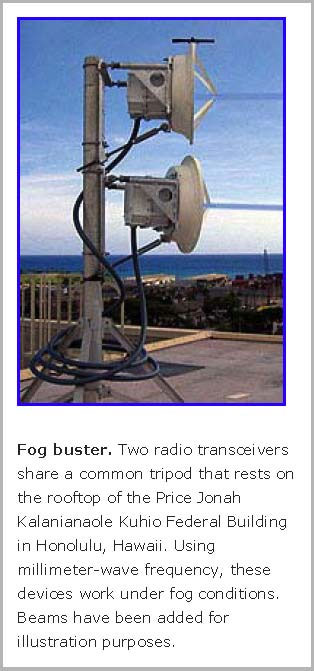News Articles
 |
SUMMER 2005 -ARTICLE #5104
LASER COMMUNICATIONS WITHOUT THE LASER
by Adam Gruen
Move over free-space optics. There's a new entrant in the field of wireless high-speed broadband telecommunications. It's not just fiber optics without the fiber; it's laser communications without the laser.
The new technology is called advanced millimeter-wave radio, and it may fill an important market niche in-between fiber optics and free-space optics. Trex Enterprises Corporation (San Diego, CA) created Loea Corporation based in Kihei, Maui, to develop, build, and install transmitter-receivers (transceivers) that can exchange 1.25 Gigabits per second (Gbps) at distances of up to 1.75 kilo-meters. The Loea 2000 Series Radio transmission ignores fog and clouds in a way that laser beams cannot, which makes it potentially ideal for airborne, shipborne, and island-based high-speed data exchange.
The missile defense program has fostered advanced millimeter-wave radio communications in many ways. Not only is MDA funding Trex to improve the existing technology to higher data rates of 2.5 Gbps and perhaps even 10 Gbps, but also its predecessor, BMDO, funded research and development on critical components as far back as the early 1990s. The original intent was to improve speed and capacity for airborne and satellite communications.
When the company was known as Thermo Electron Technologies Corporation and later ThermoTrex
Corporation, BMDO awarded a series of Innovative Science & Technology contracts to ThermoTrex to develop laser communications systems that could transmit sound and video at data rates of up to 1.2 Gbps over a distance of approximately 50 kilometers. ThermoTrex demonstrated a system in October 1994 at the Jet Propulsion Laboratory's Table Mountain Observatory and subsequently again in September 1995 in a 150-kilometer mountain-to-mountain test between two Hawaiian islands. ThermoTrex created a new division called Trex Communications in the hopes of commercializing the laser communications technology.
Beginning in 1995, the Army Research Laboratory funded ThermoTrex to develop imaging technology using passive millimeter-wave imaging in the 70 to 100 GHz frequency range. Millimeter-wave imaging occupies a middle ground between infrared imaging (at a shorter wavelength) and short-wave radio imaging (at the longer wavelength). The engineering expertise to design, construct, and test low-noise power amplifiers and other componentry was a springboard fo
r work on the radio transceiver. Since 2002, MDA Advanced Systems has funded refinements of millimeter-wave communications devices, improving data rates from 1.25 Gbps to 2.5 Gbps.
 |
Cutting through the clouds
In 2000, employees of the research and development division of ThermoTrex Corporation decided to spin off as an independent company called Trex Enterprises Corporation, headquartered in San Diego. It was also at that point that they decided to concentrate on advanced millimeter-wave communications. Loea Corporation was formed in May 2001.
Advanced millimeter-wave communications works much as free-space optical communications, but with an important difference: radio sends signals through clouds and fog. Lasers are very good for high-speed communications but they have a drawback: laser beams are attenuated (scattered) by dust, atmospheric disturbances, mist, fog, and clouds. There are ways around all of these problems, but at reduced range or decreased availability. Some laser communications systems rely on radio backup.
The advanced millimeter-wave radio technology had advanced to the point that Trex designers thought it could serve admirably as a mainstay and not merely a backup. The added advantage was that millimeter-wave radio signals would not be scattered by clouds or heavy fog. And above frequencies of 60 GHz, the transmissions would not be absorbed by oxygen in the atmosphere.
From a regulatory point of view, this was a new ("unlicensed") spectrum. Nobody had ever tried to transmit such extremely short-wave radio frequencies commercially. Working with Loea Corporation, the Federal Communications Commission (FCC) initially decided to issue Special Temporary Authority permits so that the company could install and operate equipment. In January 2004, the FCC formalized its rules and today the 71 to 76 and 81 to 86 GHz bands are licensed. Loea has installed more than half a dozen working systems for U.S. government customers such as the Coast Guard as well as with commercial partners such as Electronic Data Systems and customers such as the Hawaii Institute for Marine Biology. *B6* The typical Loea transceiver has an antenna dish measuring anywhere from 2 to 4 feet wide, uses about 40 watts of power requiring only a standard 110-volt AC input power source, and connects with a standard telecommunications network. In fact, the company has completed testing of a standard network management protocol interface, so the equipment is compatible with software tools used for monitoring the status of a network. But the best news of all may be the price, which is far less than the cost of deployed fiber-optic cable and reasonably competitive with free-space optic systems: about $60,000 for a pair of transceivers, with an additional $20,000 to $40,000 installation cost.
Advanced millimeter-wave radios could be used for any broadband communications network requiring rapid deployment, redundancy, or mobility—characteristics typical of free-space optical equipment. This includes point-to-point high-speed data transmission for points that are remote or impractically accessible such as islands, oil-drilling platforms, and ships.
Another intriguing application, one that has significance to homeland security and fire fighting, is real-time geospatial airborne surveillance. In fact, the Office of Domestic Preparedness funded Trex, in partnership with Earthdata and Raytheon, to investigate means of providing an airborne wireless link that would relay high-quality infrared images in real time to a ground-based command center for analysis. The feasibility of such a link, with obvious implications for the battlefield, was demonstrated in February 2005.